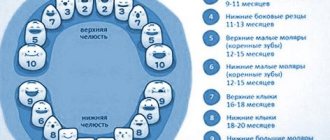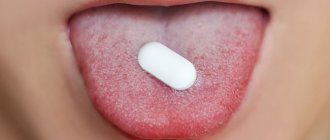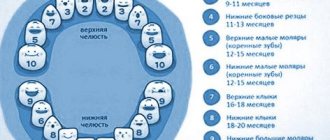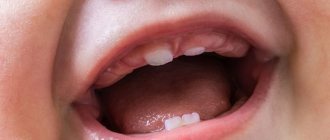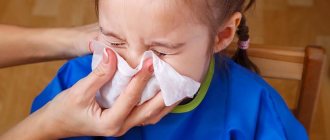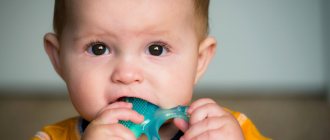If we proceed from the generally accepted canons of the formation of the dental row in a child, then by six months, maximum by 8 months, teeth should appear. However, in reality this does not always happen. Despite reaching the age of eight months, the baby does not experience teething.
Parents should not panic in such a situation, although the question of why the child has no teeth requires an immediate answer. Sometimes such a development of events is only a slight deviation from the norm, but often indicates a serious pathology.
What are normal teething symptoms?
It should be understood that teething is an ordinary physiological process that in itself does not cause serious health problems. However, children during this period may experience anxiety, be capricious, and exhibit a number of alarming symptoms. First of all, in the place where the tooth erupts, swelling and increased sensitivity of the gums are observed. The child begins to actively suck, chew and bite surrounding objects. He has increased salivation, which can irritate the skin around his mouth. These are the main symptoms that are observed in almost all babies. Fever, hyperexcitability, loss of appetite and sleep disturbances are common, but they do not appear with every new tooth. Suffice it to remember that the complete dentition is usually formed by the age of three, and children usually experience severe anxiety only in the first year of life.
For reasons unrelated to teething, the following symptoms may appear:
- increased body temperature;
- frequent bowel movements;
- nausea, vomiting;
- nasal congestion.
First of all, it is necessary to take into account the individual characteristics of the child. The symptoms inherent in a particular constitution can be summarized in a table [3].
| Allergic type (normal excitability of the central nervous system, tendency to allergic manifestations) | Lymphatic-hypoplastic type (reduced excitability of the central nervous system) | Neuro-arthritic type (increased excitability of the central nervous system) |
| Teeth are cut on time and in the correct order. Possible rash, respiratory infections, loss of appetite, and frequent bowel movements. Body temperature is normal. | Teeth cut late and in the wrong order. There is profuse drooling, runny nose, swelling and soreness of the gums, and frequent bowel movements. Body temperature is normal. | Teeth are cut on time and in the correct order. Teething causes pain, excitability, sleep and appetite disturbances, and vomiting is possible. Body temperature rises. |
Vomiting and high fever during teething, caused by the constitution, are characteristic only of the neuro-arthritic type. Only 13.1% of children fall into this category. The main types are lymphatic-plastic, its share is 53.5%, and allergic - 33.4% [3]. Thus, if a child belonging to these two types begins to vomit during teething, it is most likely due to an associated respiratory infection. However, children of the neuro-arthritic type are not protected from infection. The period of teething coincides with the introduction of complementary foods, the baby receives fewer antibodies from mother's milk, and immunity decreases. Therefore, in any case, if the body temperature rises above 38°, vomiting, or thick greenish discharge from the nose, you should call a doctor so as not to miss the onset of pneumonia, pyelonephritis or meningitis.
Teething syndrome is included in the International Classification of Diseases, but is a diagnosis of exclusion. Its signs:
- liquid transparent nasal discharge caused by excess mucus production against the background of gum inflammation (no more than 5 days);
- loose stools up to 5 times a day as a result of salivation, which increases intestinal motility;
- short-term increase in temperature, no more than 38°;
- vomiting, if infection is excluded and the child belongs to the neuro-arthritic type.
The main reasons for missing teeth
There are various physiological and pathological mechanisms that prevent the timely appearance of teeth. The main reasons for this situation are discussed below.
- Deviation in physical development. This is the most favorable option - teeth will appear soon, only the process is slightly delayed. This is a fairly common case in premature babies.
- Lack of calcium and vitamins in the baby’s body. Improperly introduced complementary foods or the use of non-adaptive mixtures leads to a deficiency of microelements. All organs and systems of the child’s body, including teeth, suffer from this. When normal nutrition is restored, teething will occur, but with a delay, sometimes significant.
- Edentia. This is a hereditary pathological condition characterized by the absence of tooth germs. In this case, chewing function can be restored artificially using implants.
- Mechanical damage to the gums. Sometimes parents make a serious mistake when trying to speed up teething on their own. They deliberately injure the gums, which leads to scars. This not only does not help, but on the contrary, it sharply slows down the process of teeth appearing.
A dentist will help determine the specific cause. Therefore, if there is a delay in the eruption of the first teeth, you cannot postpone a visit to the doctor.
How to prevent vomiting during teething in children[4]
Following simple pediatric recommendations alleviates the child’s condition and reduces the likelihood of vomiting.
- Calm the baby down. Physical well-being directly depends on his emotional state, especially with an excitable nervous system. If he is breastfed, during teething, do not wean him from the breast, do not introduce new types of complementary foods. The baby may ask for the breast more often than usual, since sucking has a sedative effect, but immediately throws it away and cries due to unpleasant sensations in the gums. Therefore, doctors do not recommend changing the feeding regimen.
- Give your baby a teether that he can gnaw and chew. It can be filled with liquid to cool the gums and relieve swelling, then it is kept in the refrigerator. Some children do not show interest in soft silicone and latex teethers, preferring to chew on crib railings or any other hard objects. In this case, a wooden teether is suitable. It is best for it to be perceived as a toy that is interesting to be distracted by. It is washed with clean water and given to the child under the supervision of parents 3-4 times a day for a short time. Make sure that the teether is intact so that your baby does not get hurt or choke on a piece of wood.
- If the pain and itching are too severe, you can use external and internal anti-inflammatory drugs (as prescribed by your doctor) to reduce them. A popular solution is special dental gels, available in pharmacies without a prescription. However, they should not be rubbed into the gums more than 2-3 times a day and you should familiarize yourself with the contraindications before use.
- Using damp cotton swabs, clean the child's nose of secretions to allow him to breathe freely and prevent a secondary infection. Pediatricians also recommend rinsing the nose with saline or sterile sea water, which can be purchased at the pharmacy in the form of drops or sprays.
Some dental gels can be purchased without a prescription.
Many are made with benzocaine (check the product label). The US Food and Drug Administration (FDA) warns against using them without medical supervision. FDA recommends that parents of children under 2 years of age not use medications containing benzocaine American Dental Association [6]
Late teeth in children - a problem or the norm?
We have already described in detail what a child’s first teeth are in the article “A Child’s First Teeth – Joy and Responsibility”, what complications there may be during this period of the baby’s development, on a separate page of the site we provide a visual aid on how children’s teeth come in, a photo and a growth chart milk teeth.
In special medical articles, our dentists provide advice and recommendations on how to make this time easier for your baby, how to properly care for the mouth and first teeth (“A pediatric dentist is a must-have best friend from an early age”). Separately, we also focused on the question: what time do children start teething? We repeat - this process is very individual and depends on many factors: heredity, the mother’s lifestyle and nutrition during pregnancy, the baby’s nutrition and the individual characteristics of his body.
Timing of teething in children
Sometimes children are already born with one or more teeth (on average, 1 case per 2-2.5 thousand babies). There is nothing wrong with this, just like with the very early eruption of baby teeth - before 3 months. Parents are even more concerned about late teething in children under one year old. We would like to point out that this is a completely normal condition. The generally accepted standard is 5-7 months - this is the average age of appearance of baby teeth. But the first teeth can appear at 9, 10, 11 months. This is especially true for babies who were born prematurely. And in very premature babies, their first teeth can be delayed even up to 15-18 months. And there's nothing wrong with that. It’s just that when the time comes, the teeth will appear, and, as a rule, by the age of three, such children have a full set of milk teeth, catch up with their peers in all other indicators.
It was previously believed that late teeth in children were often a consequence of rickets and anemia, but modern research has shown that this is not the case. Of course, a lack of calcium and microelements also affects the dental system, but the timing of teething in children is a genetically determined feature of the body. Just like the wrong order of appearance of baby teeth. Even if there are gaps in the dentition, before the eruption of a full set of baby teeth, this is not considered a pathology.
If your child is 10 months old and has no teeth , don’t worry. See our dentist - he will dispel your doubts. But if at the age of 3-4 years the baby is missing several milk teeth, consult an orthodontist at the Utkinzub clinic, who will find out the cause of the pathology and determine measures to avoid such problems with permanent teeth.
What should oral hygiene be like when teething?
Oral hygiene and caries prevention are important to reduce the likelihood of secondary infection. Brush your baby's teeth using a special napkin impregnated with xylitol and anti-inflammatory components (sold in pharmacies without a prescription). Do not give your child sweet food or drink, especially at night; Do not dip the pacifier in honey or sugar. When the first tooth emerges, visit your pediatric dentist to schedule periodic checkups [6]. Maintain a calm atmosphere in the house and carefully follow the pediatrician's instructions, this will help the child cope with teething easier.
In the absence of lateral teeth
With the early removal of several lateral teeth, depending on the adaptation mechanism, the following may form: - deep bite: the height on the sides is lost, and the lower front teeth begin to reach the mucous membrane of the palate. At the same time, the face is visually shortened. - mesial bite: in the absence of lateral teeth, chewing will be transferred to the incisors - they will experience functional overload and wear out. The jaw will move forward, and in this position it will be fixed at the skeletal level. - open bite: in the absence of two or three teeth nearby, muscle balance is disturbed and so-called “bad habits” are formed: tongue protruding, cheeks sucking into the area of missing teeth. In the future, this will interfere with the eruption of permanent replacement teeth, leading to non-occlusion of these teeth. - Crossbite: Removing side teeth on one side will force the child to chew only on the opposite side. Such chewing will lead to a sideways displacement of the lower jaw, the formation of a crossbite and asymmetry of the face and temporomandibular joints.
In the absence of front teeth
With early removal of the upper front teeth, we can observe the following changes: - lack of load in the anterior area leads to underdevelopment of this zone, the formation of a lack of space and reverse overlap - the upper lip recedes, the lower lip protrudes forward. The lower teeth tilt too far forward, and the anterior part of the upper jaw does not receive any stimulus for further development. There is a shortage of space. - the process of biting food is disrupted - bad habits arise - tongue protruding, lip sucking. In the future, this will prevent the correct and timely eruption of the front teeth. An open bite may form, the teeth will not be able to reach each other (the tongue will usually lie there) - and will not be able to fully perform their function of biting, inherent by nature. - the absence of more than two front teeth makes it difficult to form speech - mainly hissing and whistling sounds are affected.
What to do if you lose baby teeth early?
Fortunately, prompt orthodontic treatment can help prevent the negative consequences of early loss of baby teeth. Most often, removable and fixed prophylactic dentures are used to replace missing teeth.
Fixed dentures can be installed if one tooth is missing. Such devices look like a ring resting on the tooth adjacent to the missing one. A “foot” extends from the ring, which holds the space from moving adjacent teeth. Such devices will last until the teeth change and do not require replacement, as they do not interfere with jaw growth.
Removable dentures are used when two or more teeth are missing in the jaw. They look like plates with artificial teeth. Such devices must be changed at intervals of 10-12 months until the corresponding teeth erupt.
Preventive dentures have a simple design, are made only from safe materials, are hygienic, and do not interfere with jaw growth. These are the rules that underlie the orthodontic appliances you choose.
In case of premature loss of a baby tooth, the orthodontist evaluates the child’s bite, studies a computer tomogram to assess the rudiments of teeth and make a prognosis for teething, asks about the child’s bad habits, the characteristics of his temperament, and the level of home hygiene. All this data is taken into account when choosing treatment tactics. Sometimes the orthodontist recommends seeking the help of a speech therapist or prescribes muscle-gymnastic exercises to restore muscle balance.
Causes of eruption disorders
As we noted earlier, the formation of teeth and their further formation occur in the early stages of pregnancy. Therefore, a common cause of pathologies are disturbances in the development of the fetus in the first 4 weeks of development or diseases suffered by the mother during pregnancy. There is probably no need to say that the first trimester is key and most important, because at this time all the systems of the future person are laid.
Diseases that can cause incorrect development of teeth include the following:
- rubella;
- congenital syphilis;
- measles and other dangerous diseases.
Bad habits of the mother and her environment negatively affect the development of the fetus: smoking (active and passive), drinking alcohol, taking medications prohibited for use by pregnant women, and so on.
There is no denying that hereditary factors and unique characteristics of the body significantly influence the eruption of baby teeth.

